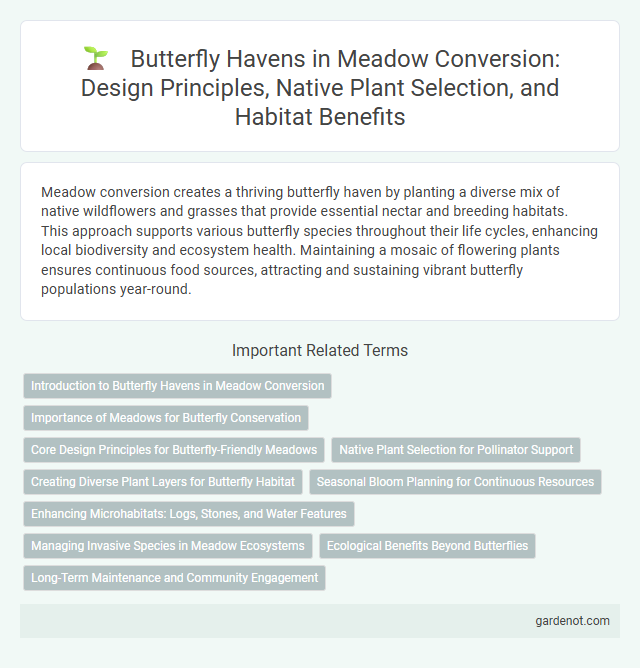Meadow conversion creates a thriving butterfly haven by planting a diverse mix of native wildflowers and grasses that provide essential nectar and breeding habitats. This approach supports various butterfly species throughout their life cycles, enhancing local biodiversity and ecosystem health. Maintaining a mosaic of flowering plants ensures continuous food sources, attracting and sustaining vibrant butterfly populations year-round.
Introduction to Butterfly Havens in Meadow Conversion
Butterfly havens in meadow conversion create essential habitats that support diverse butterfly species by providing nectar-rich flowers and host plants for caterpillars. Establishing a butterfly haven enhances local biodiversity, promoting pollination and ecological balance within meadow ecosystems. Integrating native plant species tailored for butterfly life cycles maximizes habitat suitability and sustainability.
Importance of Meadows for Butterfly Conservation
Meadows provide essential habitats rich in native wildflowers and host plants that support butterfly lifecycles, fostering high biodiversity crucial for conservation efforts. These natural environments offer shelter, nectar sources, and breeding grounds, directly influencing butterfly population stability and growth. Conserving and restoring meadows effectively counters habitat loss, ensuring vital ecosystems sustain diverse butterfly species and promote ecological resilience.
Core Design Principles for Butterfly-Friendly Meadows
Butterfly-friendly meadows prioritize native flowering plants that provide nectar throughout the butterfly lifecycle, supporting species diversity and population growth. Designing with structural variety, including host plants for caterpillars and shelter from predators, enhances habitat suitability and ecological balance. Incorporating pesticide-free practices and maintaining seasonal plant diversity ensures long-term sustainability and resilience of butterfly habitats.
Native Plant Selection for Pollinator Support
Butterfly Haven prioritizes native plant selection to enhance pollinator support by incorporating species such as milkweed, coneflowers, and black-eyed Susans, which provide essential nectar and habitat for local butterfly populations. These native plants contribute to biodiversity by sustaining pollinators like monarchs and swallowtails throughout their life cycles. Strategic planting of these pollinator-friendly natives ensures increased butterfly activity and promotes ecological balance within meadow conversion projects.
Creating Diverse Plant Layers for Butterfly Habitat
Creating diverse plant layers for Butterfly Haven supports a rich butterfly habitat by incorporating native wildflowers, shrubs, and grasses that provide nectar sources and breeding sites. Structural variety in plant height and density offers shelter and microclimates essential for different butterfly species throughout their life cycles. This multi-layered vegetation enhances biodiversity and promotes a sustainable ecosystem within meadow conversions.
Seasonal Bloom Planning for Continuous Resources
Butterfly Haven designs seasonal bloom plans to ensure continuous nectar and pollen resources throughout the year, supporting diverse butterfly species' life cycles. Strategic planting incorporates early spring blossoms like milkweed and late fall flowers such as goldenrod to maintain resource availability during critical migratory and reproductive periods. Thoughtful bloom sequencing enhances habitat sustainability and promotes butterfly population resilience.
Enhancing Microhabitats: Logs, Stones, and Water Features
In butterfly havens, enhancing microhabitats with logs, stones, and water features creates essential shelter and breeding grounds for diverse butterfly species. Decaying logs provide moisture retention and nutrient-rich environments for caterpillars, while stones serve as sunbathing spots that regulate butterfly body temperature. Integrating shallow water features supports hydration and mineral intake, crucial for butterfly survival and reproductive success.
Managing Invasive Species in Meadow Ecosystems
Effective management of invasive species in butterfly havens is crucial for maintaining biodiversity and promoting native flora growth within meadow ecosystems. Techniques such as targeted removal, regular monitoring, and the introduction of native predator species help suppress invasive plants like Japanese knotweed and garlic mustard. These efforts restore habitat quality, ensuring essential nectar sources and breeding grounds remain available for native butterfly populations.
Ecological Benefits Beyond Butterflies
Butterfly havens foster diverse plant species that support a wide range of pollinators and other beneficial insects, enhancing overall biodiversity. These habitats contribute to soil health through improved nutrient cycling and increased organic matter. By providing shelter and food sources, butterfly havens create resilient ecosystems that support birds, small mammals, and amphibians, promoting ecological balance beyond just butterflies.
Long-Term Maintenance and Community Engagement
Long-term maintenance of Butterfly Havens involves regular monitoring of native plant growth, invasive species control, and habitat restoration to ensure sustained biodiversity. Community engagement fosters stewardship through educational workshops, citizen science programs, and volunteer planting events, creating a strong network of local advocates. These collaborative efforts enhance habitat resilience and promote ecological balance within meadow conversion projects.
Butterfly haven Infographic

 gardenot.com
gardenot.com